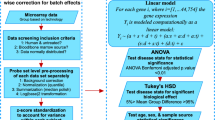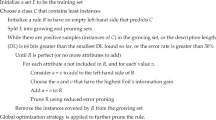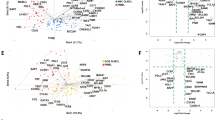Abstract
Recent reports support a possible future application of gene expression profiling for the diagnosis of leukemias. However, the robustness of subtype-specific gene expression signatures has to be proven on independent patient samples. Here, we present gene expression data of 34 adult acute lymphoblastic leukemia (ALL) patients (Affymetrix U133A microarrays). Support Vector Machines (SVMs) were applied to stratify our samples based on given gene lists reported to predict MLL, BCR-ABL, and T-ALL, as well as MLL and non-MLL gene rearrangement positive pediatric ALL. In addition, seven other B-precursor ALL cases not bearing t(9;22) or t(11q23)/MLL chromosomal aberrations were analyzed. Using top differentially expressed genes, hierarchical cluster and principal component analyses demonstrate that the genetically more heterogeneous B-precursor ALL samples intercalate with BCR-ABL-positive cases, but were clearly distinct from T-ALL and MLL profiles. Similar expression signatures were observed for both heterogeneous B-precursor ALL and for BCR-ABL-positive cases. As an unrelated laboratory, we demonstrate that gene signatures defined for childhood ALL were also capable of stratifying distinct subtypes in our cohort of adult ALL patients. As such, previously reported gene expression patterns identified by microarray technology are validated and confirmed on truly independent leukemia patient samples.
This is a preview of subscription content, access via your institution
Access options
Subscribe to this journal
Receive 12 print issues and online access
$259.00 per year
only $21.58 per issue
Buy this article
- Purchase on Springer Link
- Instant access to full article PDF
Prices may be subject to local taxes which are calculated during checkout






Similar content being viewed by others
References
Jaffe ES, Harris NL, Stein H, Vardiman JW . World Health Organization Classification of Tumours. Pathology and Genetics of Tumours of Haematopoietic and Lymphoid Tissues. Lyon: IARC Press, 2001.
Golub TR, Slonim DK, Tamayo P, Huard C, Gaasenbeek M, Mesirov JP et al. Molecular classification of cancer: class discovery and class prediction by gene expression monitoring. Science 1999; 286: 531–537.
Armstrong SA, Staunton JE, Silverman LB, Pieters R, Den Boer ML, Minden MD et al. MLL translocations specify a distinct gene expression profile that distinguishes a unique leukemia. Nat Genet 2002; 30: 41–47.
Kern W, Kohlmann A, Wuchter C, Schnittger S, Schoch C, Mergenthaler S et al. Correlation of protein expression and gene expression in acute leukemia. Cytometry 2003; 55B: 29–36.
Kohlmann A, Schoch C, Schnittger S, Dugas M, Hiddemann W, Kern W et al. Molecular characterization of acute leukemias by use of microarray technology. Genes Chromosomes Cancer 2003; 37: 396–405.
Schoch C, Kohlmann A, Schnittger S, Brors B, Dugas M, Mergenthaler S et al. Acute myeloid leukemias with reciprocal rearrangements can be distinguished by specific gene expression profiles. Proc Natl Acad Sci USA 2002; 99: 10008–10013.
Yeoh EJ, Ross ME, Shurtleff SA, Williams WK, Patel D, Mahfouz R et al. Classification, subtype discovery, and prediction of outcome in pediatric acute lymphoblastic leukemia by gene expression profiling. Cancer Cell 2002; 1: 133–143.
Ferrando AA, Neuberg DS, Staunton J, Loh ML, Huard C, Raimondi SC et al. Gene expression signatures define novel oncogenic pathways in T cell acute lymphoblastic leukemia. Cancer Cell 2002; 1: 75–87.
Dugas M, Schoch C, Schnittger S, Haferlach T, Danhauser-Riedl S, Hiddemann W et al. A comprehensive leukemia database: integration of cytogenetics, molecular genetics and microarray data with clinical information, cytomorphology and immunophenotyping. Leukemia 2001; 15: 1805–1810.
Liu G, Loraine AE, Shigeta R, Cline M, Cheng J, Valmeekam V et al. NetAffx: Affymetrix probesets and annotations. Nucleic Acids Res 2003; 31: 82–86.
Tusher VG, Tibshirani R, Chu G . Significance analysis of microarrays applied to the ionizing radiation response. Proc Natl Acad Sci USA 2001; 98: 5116–5121.
Eisen MB, Spellman PT, Brown PO, Botstein D . Cluster analysis and display of genome-wide expression patterns. Proc Natl Acad Sci USA 1998; 95: 14863–14868.
Hilsenbeck SG, Friedrichs WE, Schiff R, O’Connell P, Hansen RK, Osborne CK et al. Statistical analysis of array expression data as applied to the problem of tamoxifen resistance. J Natl Cancer Inst 1999; 91: 453–459.
Hubbell E, Liu WM, Mei R . Robust estimators for expression analysis. Bioinformatics 2002; 18: 1585–1592.
Liu WM, Mei R, Di X, Ryder TB, Hubbell E, Dee S et al. Analysis of high density expression microarrays with signed-rank call algorithms. Bioinformatics 2002; 18: 1593–1599.
Brown MP, Grundy WN, Lin D, Cristianini N, Sugnet CW, Furey TS et al. Knowledge-based analysis of microarray gene expression data by using support vector machines. Proc Natl Acad Sci USA 2000; 97: 262–267.
Furey TS, Cristianini N, Duffy N, Bednarski DW, Schummer M, Haussler D . Support vector machine classification and validation of cancer tissue samples using microarray expression data. Bioinformatics 2000; 16: 906–914.
Vapnik V . Statistical Learning Theory. New York: Wiley, 1998.
Bene MC, Castoldi G, Knapp W, Ludwig WD, Matutes E, Orfao A et al. Proposals for the immunological classification of acute leukemias. European Group for the Immunological Characterization of Leukemias (EGIL). Leukemia 1995; 9: 1783–1786.
Leo A, Wienands J, Baier G, Horejsi V, Schraven B . Adapters in lymphocyte signaling. J Clin Invest 2002; 109: 301–309.
Rozovskaia T, Ravid-Amir O, Tillib S, Getz G, Feinstein E, Agrawal H et al. Expression profiles of acute lymphoblastic and myeloblastic leukemias with ALL-1 rearrangements. Proc Natl Acad Sci USA 2003; 100: 7853–7858.
Kawagoe H, Humphries RK, Blair A, Sutherland HJ, Hogge DE . Expression of HOX genes, HOX cofactors, and MLL in phenotypically and functionally defined subpopulations of leukemic and normal human hematopoietic cells. Leukemia 1999; 13: 687–698.
Masternak K, Muhlethaler-Mottet A, Villard J, Zufferey M, Steimle V, Reith W . CIITA is a transcriptional coactivator that is recruited to MHC class II promoters by multiple synergistic interactions with an enhanceosome complex. Genes Dev 2000; 14: 1156–1166.
Villadangos JA, Ploegh HL . Proteolysis in MHC class II antigen presentation: who's in charge? Immunity 2000; 12: 233–239.
Schwarz G, Brandenburg J, Reich M, Burster T, Driessen C, Kalbacher H . Characterization of legumain. Biol Chem 2002; 383: 1813–1816.
Liu C, Sun C, Huang H, Janda K, Edgington T . Overexpression of legumain in tumors is significant for invasion/metastasis and a candidate enzymatic target for prodrug therapy. Cancer Res 2003; 63: 2957–2964.
Weiner HL, Huang H, Zagzag D, Boyce H, Lichtenbaum R, Ziff EB . Consistent and selective expression of the discoidin domain receptor-1 tyrosine kinase in human brain tumors. Neurosurgery 2000; 47: 1400–1409.
Dyer MJ . The role of CAMPATH-1 antibodies in the treatment of lymphoid malignancies. Semin Oncol 1999; 26: 52–57.
Acknowledgements
This study was supported by a grant from the Deutsche José Carreras Leukämie-Stiftung e.V. (DJCLS-R00/13).
Author information
Authors and Affiliations
Additional information
Supplementary information accompanies this paper on the Cell Death and Differentiation website: http://www.nature.com/cdd
Rights and permissions
About this article
Cite this article
Kohlmann, A., Schoch, C., Schnittger, S. et al. Pediatric acute lymphoblastic leukemia (ALL) gene expression signatures classify an independent cohort of adult ALL patients. Leukemia 18, 63–71 (2004). https://doi.org/10.1038/sj.leu.2403167
Received:
Accepted:
Published:
Issue Date:
DOI: https://doi.org/10.1038/sj.leu.2403167
Keywords
This article is cited by
-
Immune stress suppresses innate immune signaling in preleukemic precursor B-cells to provoke leukemia in predisposed mice
Nature Communications (2023)
-
Detection of HIV-1 progression phases from transcriptional profiles in ex vivo CD4+ and CD8+ T cells using meta-heuristic supported artificial neural network
Multimedia Tools and Applications (2022)
-
Childhood Acute Leukemias in Developing Nations: Successes and Challenges
Current Oncology Reports (2021)
-
Infectious stimuli promote malignant B-cell acute lymphoblastic leukemia in the absence of AID
Nature Communications (2019)
-
Quantitative comparison of microarray experiments with published leukemia related gene expression signatures
BMC Bioinformatics (2009)



